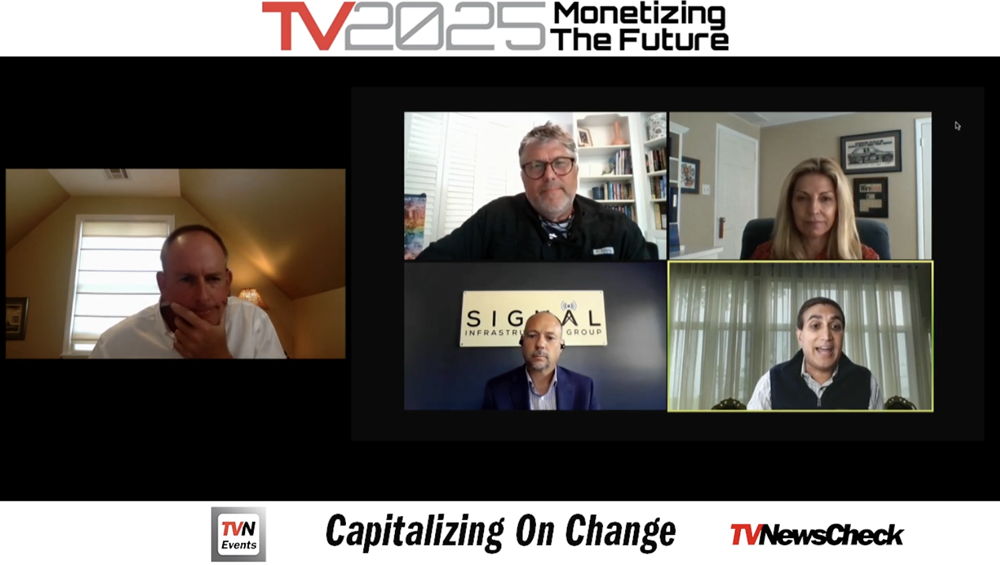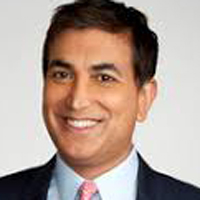
Targeted Ads Lead NextGen TV’s Revenue Chase, Execs Say

While the ATSC 3.0 next-generation broadcast standard gives broadcasters the flexibility to deliver a bevy of new services including UHD, mobile TV and datacasting, the most compelling revenue opportunity is using 3.0’s broadband pipe to deliver targeted ads to connected TVs (CTVs), according to broadcast executives speaking at TVNewsCheck’s virtual TV2025 conference last week.
The big potential of digital advertising insertion (DAI) for 3.0, or NextGenTV, is due both to growth in broadcasters’ existing OTT advertising businesses and the quick proliferation of NextGenTV-enabled TV sets into consumer households. And DAI can leverage ad-delivery and back-office software that broadcasters are already using today.

Shawn Makhijani
“The biggest opportunity is digital ad insertion, with targeting and interactivity,” said Shawn Makhijani, SVP of business development and strategy, TV and streaming for NBCUniversal Local. “This is the game changer. When we bring up OTT, people tend to focus on the content part of it, which is very legitimate and people love seeing all the shows, whatever the new hot show is. But in reality, what OTT did is transform television advertising. It allowed television to essentially become Google, Facebook.”
Makhijani runs NBC SpotOn, the OTT aggregation business that launched in 2020 and sells targeted local and regional spots for the NBCUniversal Local stations as well as on behalf of partner stations. He noted that back in 2008 broadcasters were lamenting the shift in ad dollars to digital platforms, but since then Google and other big digital companies haven’t been able to break into core television. Meanwhile, broadcasters still lacked the ability to target with their “one-dimensional” ATSC 1.0 standard.
“It was whatever was put out, and you could contextually target it based on programming, and that was pretty much it,” Makhijani said. “With ATSC 3.0, essentially the platform has been built in the same way as Android, iOS — any digital, OTT operating system. We can leverage all of our infrastructure to now deliver the same essential DAI product, with the targeting, demo, auto-intender, whatnot, and have interactive ads that can click out for commerce, click out for coupons. And that’s all being developed as we speak. I think that’s the biggest opportunity.”
NextGen TV will also solve the longtime measurement problem for local TV, he added, as broadcasters will now enjoy real-time aggregated measurement of who’s watching without having to rely on cable operators or other multichannel video programming distributors (MVPDs) to share set-top box data.

Kerry Oslund
Kerry Oslund, VP of strategy and business development for E.W. Scripps, spoke about successful testing of automotive applications in Detroit and other markets by Scripps and other members of the Pearl TV consortium. While he said the automotive results are encouraging, he was also clear that targeted ads are a bigger near-term opportunity for broadcasters.
“It’s nice to talk about optionality and ancillary income and monetization opportunities with delivering data to automobiles,” Oslund said. “But everything that Shawn just said, is actually the priority that we look at, too.”
More Sets Available
As they look to build out targeted advertising with NextGenTV, broadcasters can take advantage of a connected TV market that is exploding, and one in which many new connected TVs will also have NextGenTV reception capability. Anne Schelle, managing director of Pearl TV, says that broadcasters are catching CTV at its “hockey stick” moment, as consumers are rapidly taking advantage of new TV sets with built-in streaming capability that replaces early peripheral streaming devices. And streaming use has greatly increased in the past year and a half with many consumers cooped up at home due to the COVID-19 pandemic.
Recent Pearl TV research also indicates that consumers consider interactivity as one of the most desirable features of NextGenTV, along with advanced audio features. Schelle noted the consortium has developed a software platform to support interactive applications, Run3TV, that is available to all 3.0 broadcasters.

Anne Schelle
“That is essentially the browser that allows for the web pages to be deployed, implemented, and all of the capabilities that Shawn talked about, exercised by broadcasters,” Schelle said. “It’s the digital teams that can easily do this, and we have markets up today enabling DAI on their OTT side, their hybrid channels that they’re pulling in. They’re also doing lead generation, connecting into their Google Analytics and they’re also connecting to their entire back office.”
Since first hitting retail shelves in April 2020, more than three million NextGen TVs have already been sold, Schelle said, outpacing sales of 4K HDTV sets, DVD players and streaming set-top boxes. One hundred percent of Sony’s TV sets now have NextGenTV reception capability, Samsung and LG are extending NextGenTV into their mid-tier sets and several new manufacturers plan to roll out NextGenTV sets next year, she added.
Pearl TV expects that there will be more than 45 million NextGenTV sets in households by 2024.
“I think you’re going to see a pretty quick proliferation of almost 100% ubiquity for NextGen on all TV sets by 2025,” Schelle said. “45 million sets are sold a year, so I’ll let you do the math.”
Motown Test Track
Forty-four NextGenTV markets are up today, and E.W. Scripps is involved in about a quarter of them, Oslund said, with its stations often serving as the 3.0 “lighthouse” in the market. One of them is WMYD Detroit, which is sharing channel capacity with Graham Media, Fox and CBS. The four companies have carved out 10% of their overall 3.0 capacity for the exclusive use and experimentation of the automotive industry and its vendors in a pilot called the “Motown 3.0 Test Track,” which is managed by Pearl TV and its partners.
“It’s a big-time invitation for anyone who wants to get their hands dirty in broadcast internet to come see what we have to offer,” Oslund said. “We’re starting to prove over and over again receivability, reliability, and certainly, when we look at the modeling, super affordability.”
Consumer electronics firms, automobile manufacturers and prospective entrants into the automotive market have all taken advantage of the “Test Track.” Broadcasters have also expanded the track’s footprint to experiment with single-frequency network and multi-frequency networks, including handoffs of signals between markets, proving the ability to “cellularize” the 3.0 broadcast system to provide similar mobile functionality as wireless networks.
While it may be farther out as a revenue opportunity compared to targeted ads, Oslund said the Broadcast Internet capabilities of 3.0 open up a “whole different possible set of customers who have interest in using one-to-many technologies, if for no other reason than to greatly reduce their bandwidth costs.” He noted that a study of RF patterns shows that groups like Scripps often have contiguous spectrum over broad geographic areas, allowing them to keep automobiles or internet of things (IoT) devices in a “bubble of data” no matter where they went.
“If you took a look at our footprint in Florida, for instance, you would see that six transmitters can pretty much blanket the state of Florida, where it would take literally hundreds of cellphone towers to do the same,” Oslund said. “Now I’m not suggesting it’s one versus the other, I’m just suggesting we have a way to deliver data in a very efficient manner using existing infrastructure and working with the 5G and 4G providers. Because there are always going to be gaps — there’s always going to be a mountain, there’s always going to be a tunnel, there’s always going to be a need.”
Single-Frequency Networks

Jim Stenberg
To ensure robust mobile reception for 3.0, single-frequency networks of multiple transmitters in a market will likely be required to provide more signal than a single stick can deliver, said Signal Infrastructure Group (SIG) EVP Jim Stenberg. His company is undertaking the design and construction of a nationwide SFN footprint along with developing a software platform to support app generation, intake, scheduling and delivery through the cloud.
SIG already has paying customers for distance learning and emergency alerting applications with ATSC 1.0 applications, which it is looking to extend to 3.0. The company is also working to create a spectrum exchange or brokerage to assist buyers and sellers in finding over-the-air capacity.
“We’re working on a model for that exchange that is basically based on a financial brokerage-type model,” Stenberg said. “And our model does not have any control over station bandwidth, it’s merely an introductory or broker-type relationship.”
While he conceded that some data customers may wind up using 3.0 in a hybrid model alongside wireless networks like 4G and 5G, he encouraged broadcasters to develop and promote their own 3.0 data services that don’t require cooperation from the wireless industry.
“We as a broadcast industry need to focus on being able to deliver our service as much by ourselves as we can,” Stenberg said. “Because the wireless carriers are always going to have their own interests, and we’ve seen that they don’t necessarily align with broadcaster needs and business models.
“We need to build out business models that revolve around this new delivery platform and not around providing additional delivery for wireless services,” he said. “The fact is, we’re able to deliver bits so effectively cost-wise that there will be benefits to moving things that are currently done with wireless carriers over to ATSC 3.0. Anything that’s currently one-way type of information, we can do that so much more cost-effectively that there won’t be a need to interface with wireless.”
Interestingly, there wasn’t much discussion of using 3.0 to deliver UHD formats like 4K HDR. Schelle noted that the base format the Pearl TV stations have specified to deliver is 1080p with high dynamic range (HDR), which is still a big quality jump from 1.0’s 720p and 1080i HD formats.
NBC delivered some 4K HDR programming to MVPD partners during the Tokyo Olympics, and one of them, YouTube TV, actually charged a premium for the 4K content. But whether a 4K premium tier of programming that would be provided only to MVPDs will prove viable in the future remains to be seen, Makhijani said.
“I think that will all play out, and we’ll see the use case that comes out of it,” he said. “But either way over-the-air will see a significant improvement, and that will still be free.”
To watch the video of this session, click here.
For more TV2025 2021 stories, click here.




































Comments (4)
SunnyAnd75 says:
September 27, 2021 at 9:59 am
An important aspect of targeted advertising specifically related to ATSC 3.0 are the new “gatekeepers”- MVPDs and television manufacturers. Broadcasters today benefit from MVPDs that pay them for the rights to carry their signals. Today, television manufacturers pass these signals through without any interruption or overlay. However, because ATSC 3.0 broadcasting is a 1-way, one-to-many medium that requires full cooperation from the MVPD and set manufacturers to deliver internet based data (or local storage if the ad is delivered via the 3.0 signal), these new gatekeepers want a share of the revenue. Suddenly, MVPDs now have new leverage when broadcasters are asking for their next re-trans rate increase. Also worth noting, the same applies to any return data that stations are hoping to receive, such as viewing data of the broadcaster’s own signal. Sadly, 3.0 does not work quite as simply as the internet. ATSC 3.0 is the equivalent of Apple getting a share of every banner ad on a station website simply because it was viewed on an iPhone.
TVNewscheck, I would encourage you to ask Sony/LG/Samsung if they intend to allow broadcasters to do targeted advertising purely as a “set feature”. This is an important area that is continuously overlooked during 3.0 targeted advertising discussions. Our preliminary investigations found that set manufacturers are anticipating somewhere between 15-25%, potentially washing away any gains as a result of targeted advertising.
KO says:
September 27, 2021 at 12:48 pm
We fully expect to work out win win deals with CEs and other enablers. With Project Oar, participants pay a CPM for replaced ads delivered by Vizio-Inscape. Think ad serving fee (not revenue share).
Kathy Haley says:
September 27, 2021 at 2:25 pm
Thanks for the really important comments, SunnyAnd75 and KO. I was fascinated by the conversation with station group CEOs during last week’s TV2025 conference, when they talked about how it might be time for cooperation with cable operators on interactive advertising. This is an old idea that never went anywhere in the 1990s, but could gain steam as NextGen TV moves toward achieving scale. We will indeed pursue stories on ad serving fees that could be charged by set manufacturers and the MVPDs. To watch the CEO panel video, the Optimizing Spot TV video or the C-Suiter’s Guide to Capitalizing on the Cloud, visit the TV2025 playlist on TVNewsCheck’s Vimeo channel: https://vimeo.com/showcase/8856350
ronanhigg says:
December 14, 2021 at 5:07 pm
@SunnyAnd75 would you be available for a conversation on your preliminary investigations? An important question that needs to be answered is how many of the 45 million Nextgen TV sets in households by 2024 will support ATSC 3.0 “service usage reporting” (viewing return path data), and how many will support ATSC 3.0 targeted advertising.
The rollout of HbbTV in other markets enabled broadcasters to get into the TV set without cost (so far). The US market is unlikely play out so favorably to the broadcaster, because the TV OEMs have made considerable investments in proprietary data collection and ad insertion technology. Ronan Higgins